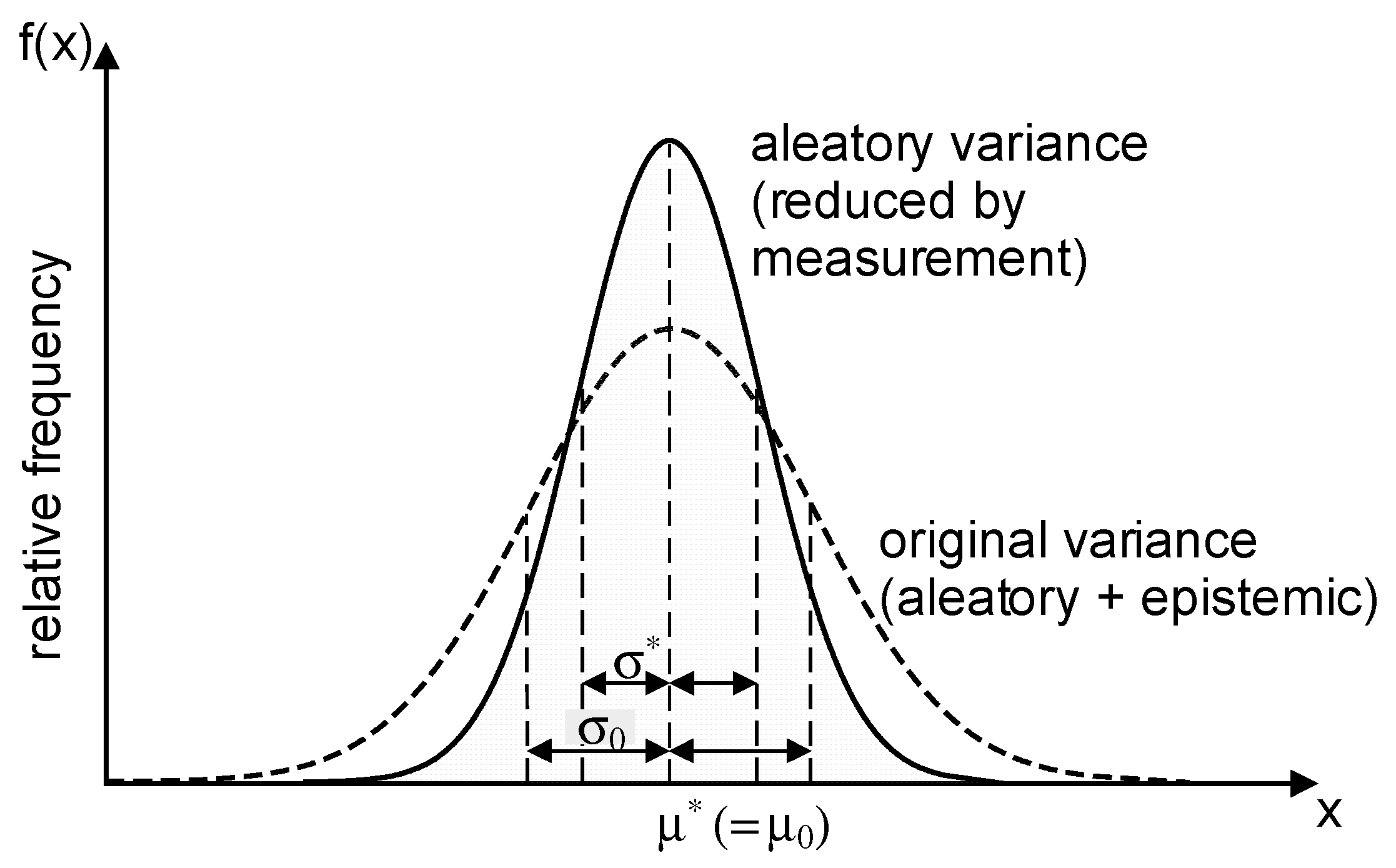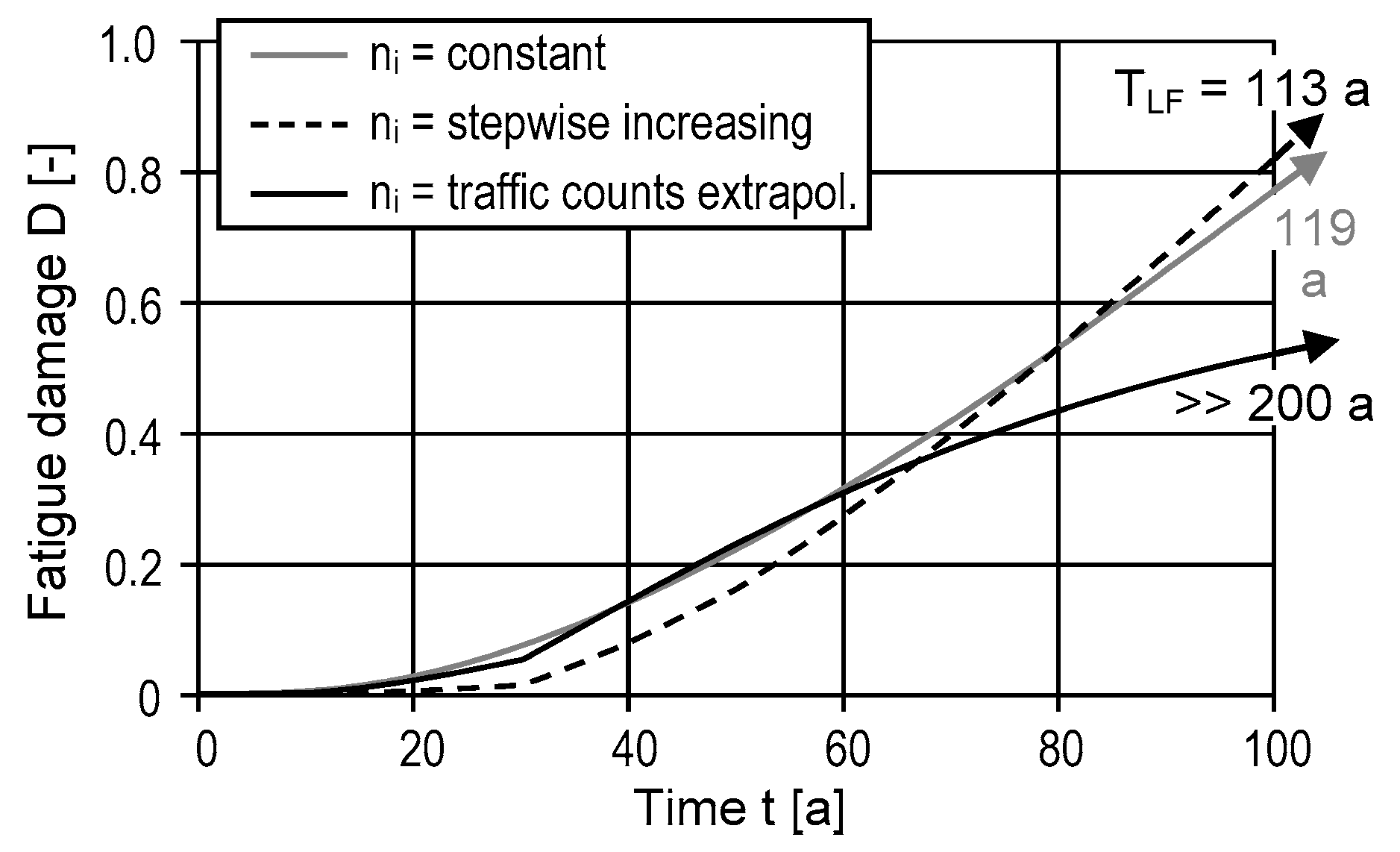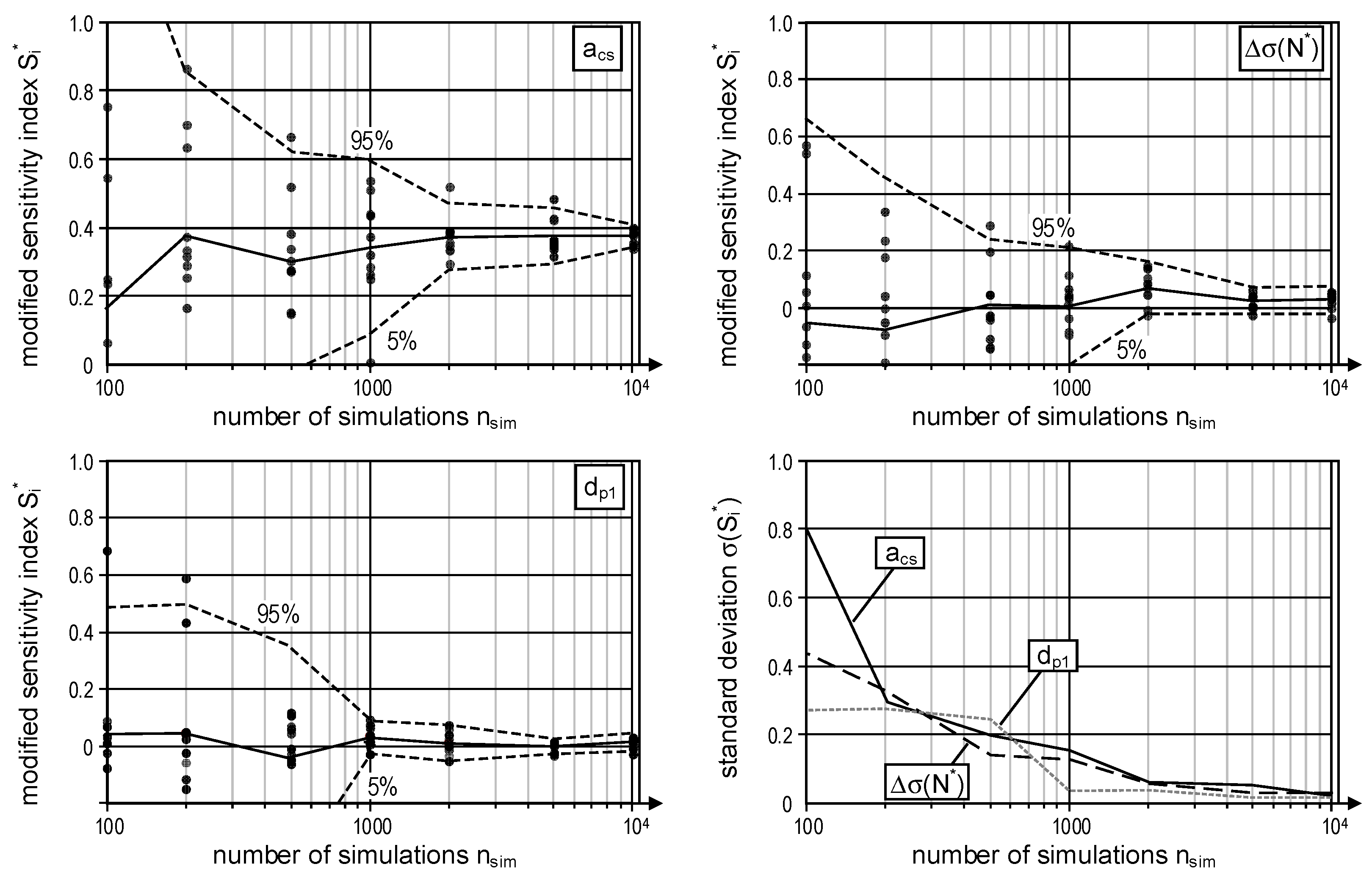Modification of Variance-Based Sensitivity Indices for Stochastic Evaluation of Monitoring Measures
Abstract
1. Introduction
2. Variance-Based Sensitivity Indices
2.1. Variance-Based Sensitivity Indices by Sobol’
2.2. Computation of Variance-Based Sensitivity Indices
3. Method: Modification of Variance-Based Sensitivity Indices
3.1. Proposed Method Based on SOBOL’ Indices
3.2. Computational Implementation
4. Application Case: A Model for Fatigue Lifetime Prediction of Pre-Stressed Concrete Bridges
4.1. Reference Structure and Measurements
4.2. Fatigue Lifetime Prediction Model for Pre-Stressed Concrete Bridges
- estimation and prognosis of loads (traffic loads and frequencies, temperature loads);
- calculation of stresses, including the nonlinearity after cracking (typically affected by the structural FE-model, cross-sectional and geometric parameters, material parameters, and stiffness);
- fatigue-related properties of the material resistance (represented by the S–N curve).
- the width of the deck-slab bf, which represents the variability of the entire geometry;
- the effective height dp1 of the pre-stressed cross-section concerning tendon layer no. 1;
- a scaling factor for pre-stress losses by creep and shrinkage aCS;
- five (relevant) linear temperature gradients ΔTi;
- a scaling factor w3 for the traffic loads from FLM 4, truck no. 3;
- the cross-sectional area of a tendon Ap1;
- Young’s moduli of concrete Ec and pre-stressing steel Ep;
- two parameters to describe the S–N curve: its knee point Δσ(N*) at 106 load cycles and the slope of the high-cycle fatigue range (k2); for simplification k1 is set equal to k2.
4.3. Stochastic Lifetime Prediction, Sensitivity Analysis and Evaluation of Modified Sensitivity Indices
4.4. Convergence
- The scaling factor of the pre-stress loss aCS in Figure 9 top left is a relevant parameter (STi-value is high) and can be reduced significantly (Vi*/Vi,0 << 1). Therefore, its modified sensitivity index Si* is expected to be high.
- The knee point of the S–N curve Δσ(N*) in Figure 9 top right is a relevant parameter (high STi-value) without significant variance reduction (Vi*/Vi,0 ≈ 1); thus, Si* is expected to be low.
- Third, the effective depth of the pre-stressing steel (dp1) on the lower left of Figure 9 has a low (original) total sensitivity index STi and even in case of a significant reduction of its variance, the modified sensitivity index can be expected to be low.
5. Conclusions
Author Contributions
Funding
Institutional Review Board Statement
Informed Consent Statement
Data Availability Statement
Conflicts of Interest
References
- Ahrens, M.A.; Mark, P. Lebensdauersimulation von Betontragwerken. Beton- und Stahlbetonbau. 2011, 106, 220–230. [Google Scholar] [CrossRef]
- Sanio, D.; Ahrens, M.A. Identification of relevant but stochastic input parameters for fatigue assessment of pre-stressed concrete bridges by monitoring. In Proceedings of the 1st International Conference on Uncertainty Quantification in Computational Sciences and Engineering (UNCECOMP 2015), Crete Island, Greece, 25–27 May 2015; Papadrakakis, M., Papadopoulos, V., Stefanou, G., Eds.; pp. 947–960. [Google Scholar]
- Ambrozinski, L.; Packo, P.; Pieczonka, L.; Stepinski, T.; Uhl, T.; Staszewski, W.J. Identification of material properties—efficient modelling approach based on guided wave propagation and spatial multiple signal classification. Struct. Control. Health Monit. 2015, 22, 969–983. [Google Scholar] [CrossRef]
- Žnidarič, A.; Kreslin, M.; Lavrič, I.; Kalin, J. Simplified Approach to Modelling Traffic Loads on Bridges. Procedia Soc. Behav. Sci. 2012, 48, 2887–2896. [Google Scholar] [CrossRef][Green Version]
- Löschmann, J.; Ahrens, A.; Dankmeyer, U.; Ziem, E.; Mark, P. Methoden zur Reduktion des Teilsicherheitsbeiwerts für Eigenlasten bei Bestandsbrücken. Beton. Und. Stahlbetonbau. 2017, 112, 506–516. [Google Scholar] [CrossRef]
- Ahrens, M.A. Precision-assessment of lifetime prognoses based on SN-approaches of RC-structures exposed to fatigue loads. In Life-Cycle and Sustainability of Civil Infrastructure Systems. In Proceedings of the 3rd International Symposium on Life-Cycle Civil Engineering (IALCCE), IALCCE 12, Vienna, Austria, 3–6 October 2012; Strauss, A., Frangopol, D., Berg-Meister, K., Eds.; CRC Press: Hoboken, NJ, USA, 2012; p. 109, ISBN 9780203103364. [Google Scholar]
- Gao, R.; Li, J.; Ang, A.H.-S. Stochastic analysis of fatigue of concrete bridges. Struct. Infrastruct. Eng. 2019, 15, 925–939. [Google Scholar] [CrossRef]
- Walpole, R.E.; Myers, R.H.; Myers, S.L.; Ye, K. Probability & Statistics for Engineers & Scientists, 9. Auflage; Prentice Hall: Boston, MS, USA, 2012; ISBN 0321629116. [Google Scholar]
- Strauss, A.; Hoffmann, S.; Wan-Wendner, R.; Bergmeister, K. Structural assessment and reliability analysis for existing engineering structures, applications for real structures. Struct. Infrastruct. Eng. 2009, 5, 277–286. [Google Scholar] [CrossRef]
- Saltelli, A.; Ratto, M.; Andres, T.; Campolongo, F.; Cariboni, J.; Gatelli, D.; Saisana, M.; Tarantola, S. Global Sensitivity Analysis: The Primer; John Wiley & Sons: Chichester, UK, 2008; ISBN 0470725176. [Google Scholar]
- Iooss, B.; Lemaître, P. A review on global sensitivity analysis methods // A Review on Global Sensitivity Analysis Methods. In Uncertainty Management in Simulation-Optimization of Complex Systems: Algorithms and Applications, Dellino, G., Meloni, C., Eds.; Springer: Boston, MS, USA, 2015; pp. 101–122. ISBN 978-1-4899-7546-1. [Google Scholar]
- Augusti, G.; Baratta, A.; Casciati, F. Probabilistic Methods in Structural Engineering; Chapman and Hall/CRC: Boca Raton, FL, USA, 2014; ISBN 9781482267457. [Google Scholar]
- Saltelli, A.; Annoni, P.; Azzini, I.; Campolongo, F.; Ratto, M.; Tarantola, S. Variance based sensitivity analysis of model output. Design and estimator for the total sensitivity index. Comput. Phys. Commun. 2010, 181, 259–270. [Google Scholar] [CrossRef]
- Wainwright, H.M.; Finsterle, S.; Jung, Y.; Zhou, Q.; Birkholzer, J.T. Making sense of global sensitivity analyses. Comput. Geosci. 2014, 65, 84–94. [Google Scholar] [CrossRef]
- Sanio, D.; Obel, M.; Mark, P. Screening methods to reduce complex models of existing structures. In Proceedings of the 17th International Probabilistic Workshop (IPW), Edinburgh, UK, 11–13 September 2019; pp. 51–56. [Google Scholar]
- Campolongo, F.; Cariboni, J.; Saltelli, A. An effective screening design for sensitivity analysis of large models. Environ. Model. Softw. 2007, 22, 1509–1518. [Google Scholar] [CrossRef]
- Morris, M.D. Factorial Sampling Plans for Preliminary Computational Experiments. Technometrics 1991, 33, 161. [Google Scholar] [CrossRef]
- Sobol, I.M. Global sensitivity indices for nonlinear mathematical models and their Monte Carlo estimates. Math. Comput. Simul. 2001, 55, 271–280. [Google Scholar] [CrossRef]
- Campolongo, F.; Tarantola, S.; Saltelli, A. Tackling quantitatively large dimensionality problems. Comput. Phys. Commun. 1999, 117, 75–85. [Google Scholar] [CrossRef]
- Bien, J.; Kużawa, M.; Kamiński, T. Strategies and tools for the monitoring of concrete bridges. Struct. Concr. 2020, 21, 1227–1239. [Google Scholar] [CrossRef]
- Brühwiler, E. Fatigue safety examination of riveted railway bridges using monitored data. In Bridge Maintenance, Safety, Management and Life Extension, Proceedings of the 7th International Conference of Bridge Maintenance, Safety and Management. IABMAS 2014, Shanghai, China, 7–11 July 2014; Chen, A., Frangopol, D.M., Eds.; CRC Press: Boca Raton, FL, USA, 2014; pp. 1169–1176. ISBN 9781138001039. [Google Scholar]
- Frangopol, D.M.; Strauss, A.; Kim, S. Bridge Reliability Assessment Based on Monitoring. J. Bridg. Eng. 2008, 13, 258–270. [Google Scholar] [CrossRef]
- Bayane, I.; Mankar, A.; Brühwiler, E.; Sørensen, J.D. Quantification of traffic and temperature effects on the fatigue safety of a reinforced-concrete bridge deck based on monitoring data. Eng. Struct. 2019, 196, 109357. [Google Scholar] [CrossRef]
- Treacy, M.A.; Brühwiler, E. Action effects in post-tensioned concrete box-girder bridges obtained from high-frequency monitoring. J. Civ. Struct. Health Monit. 2014, 5, 11–28. [Google Scholar] [CrossRef]
- Nair, A.; Cai, C.S. Acoustic emission monitoring of bridges: Review and case studies. Eng. Struct. 2010, 32, 1704–1714. [Google Scholar] [CrossRef]
- Marx, S.; von der Haar, C.; Liebig, J.P.; Grünberg, I.J. Bestimmung der Verkehrseinwirkung auf Brückentragwerke aus Messungen an Fahrbahnübergangskonstruktionen. Bautech 2013, 90, 466–474. [Google Scholar] [CrossRef]
- Uva, G.; Porco, F.; Fiore, A.; Mezzina, M. Proposal of a methodology for assessing the reliability of in situ concrete tests and improving the estimate of the compressive strength. Constr. Build. Mater. 2013, 38, 72–83. [Google Scholar] [CrossRef]
- Malhotra, V.M. In Situ/Nondestructive Testing of Concrete; American Concrete Institute (ACI): Detroid, MI, USA, 1984. [Google Scholar]
- Der Kiureghian, A.; Ditlevsen, O. Aleatory or epistemic? Does it matter? Struct. Saf. 2009, 31, 105–112. [Google Scholar] [CrossRef]
- Zhou, L.; Yan, G.; Wang, L.; Ou, J. Review of Benchmark Studies and Guidelines for Structural Health Monitoring. Adv. Struct. Eng. 2013, 16, 1187–1206. [Google Scholar] [CrossRef]
- ACI Committee 444. PRC-444.2-21: Structural Health Monitoring Technologies for Concrete Structures. Report; ACI Reports ACI PRC-444.2-21, Farmington Hills, Mich. 2021. Available online: https://www.concrete.org/store/productdetail.aspx?ItemID=444221 (accessed on 18 August 2021).
- Pozo, F.; Tibaduiza, D.; Vidal, Y. Sensors for Structural Health Monitoring and Condition Monitoring. Sensors 2021, 21, 1558. [Google Scholar] [CrossRef]
- Tarantola, S.; Gatelli, D.; Mara, T. Random balance designs for the estimation of first order global sensitivity indices. Reliab. Eng. Syst. Saf. 2006, 91, 717–727. [Google Scholar] [CrossRef]
- Hora, S.C.; Iman, R.L. Comparison of Maximus/Bounding and Bayes/Monte Carlo for Fault Tree Uncertainty Analysis. 1986. Available online: https://www.osti.gov/biblio/5824798 (accessed on 22 October 2021).
- Cukier, R.I.; Levine, H.B.; Shuler, K.E. Nonlinear sensitivity analysis of multiparameter model systems. J. Comput. Phys. 1978, 26, 1–42. [Google Scholar] [CrossRef]
- Sobol’, I. Theorems and examples on high dimensional model representation. Reliab. Eng. Syst. Saf. 2003, 79, 187–193. [Google Scholar] [CrossRef]
- Archer, G.E.B.; Saltelli, A.; Sobol, I.M. Sensitivity measures, anova-like Techniques and the use of bootstrap. J. Stat. Comput. Simul. 1997, 58, 99–120. [Google Scholar] [CrossRef]
- Ökten, G.; Liu, Y. Randomized quasi-Monte Carlo methods in global sensitivity analysis. Reliab. Eng. Syst. Saf. 2021, 210, 107520. [Google Scholar] [CrossRef]
- Glen, G.; Isaacs, K. Estimating Sobol sensitivity indices using correlations. Environ. Model. Softw. 2012, 37, 157–166. [Google Scholar] [CrossRef]
- Saltelli, A.; Tarantola, S.; Chan, K.P.-S. A Quantitative Model-Independent Method for Global Sensitivity Analysis of Model Output. Technometrics 1999, 41, 39–56. [Google Scholar] [CrossRef]
- Piano, S.L.; Ferretti, F.; Puy, A.; Albrecht, D.; Saltelli, A. Variance-based sensitivity analysis: The quest for better estimators and designs between explorativity and economy. Reliab. Eng. Syst. Saf. 2021, 206, 107300. [Google Scholar] [CrossRef]
- Sanio, D.; Ahrens, M.A.; Mark, P.; Rode, S. Untersuchung einer 50 Jahre alten Spannbetonbrücke zur Genauigkeitssteigerung von Lebensdauerprognosen. Beton- und Stahlbetonbau. 2014, 109, 128–137. [Google Scholar] [CrossRef]
- Sanio, D.; Ahrens, M.; Mark, P. Detecting the limits of accuracy of lifetime predictions by structural monitoring. In Proceedings of the Bridge Maintenance, Safety, Management and Life Extension; Chen, A., Frangopol, D.M., Eds.; CRC Press: Boca Raton, FL, USA, 2014; pp. 416–423. [Google Scholar]
- Sanio, D.; Ahrens, M.A.; Mark, P. Tackling uncertainty in structural lifetime evaluations. Beton- und Stahlbetonbau. 2018, 113, 48–54. [Google Scholar] [CrossRef]
- EN 1991-2: Eurocode 1: Actions on Structures: Part 2: Traffic Loads on Bridges; CEN: Brussels, Belgium, 2010.
- Sanio, D. Accuracy of Monitoring-Based Lifetime-Predictions for Prestressed Concrete Bridges Prone to Fatigue. Ph.D. Thesis, Ruhr-Universität Bochum, Bochum, Germany, 2017. [Google Scholar]
- Pålmgren, A. Die Lebensdauer von Kugellagern. Z. Des Ver. Dtsch. Ing. 1924, 68, 339–341. [Google Scholar]
- Miner, M.A. Cumulative Damage in Fatigue. J. Appl. Mech. 1945, 12, A159–A164. [Google Scholar] [CrossRef]
- Krüger, W.; Mertzsch, O. Zum Trag- und Verformungsverhalten bewehrter Betonquerschnitte im Grenzzustand der Gebrauchstauglichkeit; DAfStb-Heft No. 533; Beuth: Berlin, Germany, 2006. [Google Scholar]
- Sanio, D.; Ahrens, M.A.; Mark, P. Lifetime predictions of pre-stressed concrete bridges—Evaluating parameters of relevance using Sobol’-indices. Civ. Eng. Des. 2021. [Google Scholar] [CrossRef]
- Bažant, Z.P.; Baweja, S. Creep and shrinkage prediction model for analysis and design of concrete structures—model B3. Mater. Struct. 1995, 28, 357–365. [Google Scholar] [CrossRef]
- EN 1992-2: Eurocode 2: Design of Concrete Structures: Part 2: Concrete Bridges—Design and Detailing Rules; CEN: Brussels, Belgium, 2010.
- Sanio, D.; Mark, P.; Ahrens, M.A. Temperaturfeldberechnung für Brücken. Beton- und Stahlbetonbau. 2017, 112, 85–95. [Google Scholar] [CrossRef]









| Variable i | Distribution | Orig. Distribution | Improvement | Sensitivity Indices | |||||
|---|---|---|---|---|---|---|---|---|---|
| μi,0 | CVi,0 | CVi* | Vi*/Vi,0 | Si | STi | ||||
| Pre-strain | εp(0) | [‰] | N | 2.175 | 0.046 | 0.014 | 0.09 | 0.05 | 0.12 |
| Young’s modulus of steel | Ep | [N/mm2] | N | 205,000 | 0.030 | 0.024 | 0.63 | ~0 | 0.06 |
| Scaling factor for creep and shrinkage | aCS | [-] | N | 1 | 0.100 | 0.050 | 0.25 | 0.18 | 0.26 |
| Young’s modulus of concrete | Ec | [N/mm2] | LN | 33,000 | 0.091 | 0.045 | 0.25 | 0.02 | 0.04 |
| S–N curve: | LN | 120 | 0.008 | 0.063 | 0.88 | 0.11 | 0.11 | ||
| knee point | Δσ (N*) | [N/mm2] | |||||||
| slope | k2 | [-] | LN | 7 | 0.071 | 0.043 | 0.36 | 0.004 | 0.01 |
| Width of the deck-slab | bf | [m] | N | 4.95 | 0.101 | 0.001 | <0.01 | 0.01 | 0.05 |
| Area of a tendon | Ap1 | [cm2] | N | 26.55 | 0.016 | 0.007 | 0.21 | 0.01 | 0.04 |
| Effective height for tendon layer 1 | dp1 | [m] | N | 1.31 | 0.008 | 0.002 | 0.04 | 0.002 | 0.02 |
| Gradient of load cycles per year | dn/dt | N | 15,000 | 0.333 | 0.317 | 0.9 | 0.02 | 0.02 | |
| Scaling factor for FLM4-type 3 | w3 | [-] | N | 1 | 0.100 | 0.100 | 1 | ~0 | 0.05 |
| Temperature gradients (scaled): | 1 | 0.008 | 0.141 | 0.5 | ~0 | 0.02 | |||
| ΔT(−4 K) | N | ||||||||
| ΔT(−5 K) | N | 1 | 0.200 | 0.141 | 0.5 | 0.01 | 0.04 | ||
| ΔT(−6 K) | N | 1 | 0.200 | 0.141 | 0.5 | 0.06 | 0.18 | ||
| ΔT(−7 K) | N | 1 | 0.200 | 0.141 | 0.5 | 0.18 | 0.29 | ||
| ΔT(−8 K) | N | 1 | 0.200 | 0.141 | 0.5 | 0.14 | 0.24 | ||
| Variable i | Distribution Characteristics When i Is Improved | Relative Fractile Change | Mod. Sensitivity Index | ||||||
|---|---|---|---|---|---|---|---|---|---|
| λ | ζ | D0,90 | D0,99 | D0,90 | D0,99 | Si* | |||
| Pre-strain | εp(0) | [‰] | −1.94 | 3.189 | 8.535 | 238.8 | +11% | +16% | 0.09 |
| Young’s modulus of steel | Ep | [N/mm2] | −1.93 | 3.254 | 9.350 | 280.2 | +1% | +1% | 0.001 |
| Area of the tendon | Ap1 | [cm2] | −1.94 | 3.243 | 9.156 | 271.3 | +3% | +4% | 0.02 |
| Effective depth of the tendon | dp1 | [m] | −1.93 | 3.243 | 9.283 | 275.0 | +% | +3% | 0.02 |
| Scaling factor creep and shrinkage | aCS | [-] | −1.95 | 3.026 | 6.851 | 161.8 | +31 % | +45% | 0.29 |
| S–N curve: | |||||||||
| knee point | Δσ(N*) | [N/mm2] | −1.92 | 3.236 | 9.291 | 273.2 | +2% | +4% | 0.03 |
| slope | k2 | [-] | −1.93 | 3.249 | 9.324 | 278.0 | +1% | +2% | 0.01 |
| Young’s modulus of concrete | Ec | [N/mm2] | −1.97 | 3.245 | 8.893 | 263.9 | +7% | +7% | 0.01 |
| Width of the deck-slab | bf | [m] | −1.96 | 3.235 | 8.857 | 260.1 | +7% | +9% | 0.03 |
| Gradient of load cycles in time | dn/dt | −1.93 | 3.257 | 9.406 | 282.7 | +0% | +0% | ~0 | |
| Scaling factor FLM4-type 3 | w3 | [-] | −1.92 | 3.262 | 9.556 | 288.7 | −% | −2% | ~0 |
| Temperature gradient: | |||||||||
| ΔT(−4 K) | −1.96 | 3.284 | 9.469 | 292.8 | −0% | −4% | ~0 | ||
| ΔT(−5 K) | −1.98 | 3.260 | 9.004 | 271.4 | +5% | +4% | ~0 | ||
| ΔT(−6 K) | −2.08 | 3.201 | 7.519 | 213.2 | +23% | +26% | 0.07 | ||
| ΔT(−7 K) | −2.25 | 3.094 | 5.570 | 141.1 | +46% | +53% | 0.20 | ||
| ΔT(−8 K) | −2.19 | 3.143 | 6.268 | 167.1 | +38% | +43% | 0.14 | ||
| “best” model a* with V* | −2.92 | 2.349 | 1.099 | 12.8 | +100% | +100% | - | ||
| initial model b with V0 | −1.93 | 3.255 | 9.433 | 283.0 | ±0 | ±0 | - | ||
Publisher’s Note: MDPI stays neutral with regard to jurisdictional claims in published maps and institutional affiliations. |
© 2021 by the authors. Licensee MDPI, Basel, Switzerland. This article is an open access article distributed under the terms and conditions of the Creative Commons Attribution (CC BY) license (https://creativecommons.org/licenses/by/4.0/).
Share and Cite
Sanio, D.; Ahrens, M.A.; Mark, P. Modification of Variance-Based Sensitivity Indices for Stochastic Evaluation of Monitoring Measures. Infrastructures 2021, 6, 149. https://doi.org/10.3390/infrastructures6110149
Sanio D, Ahrens MA, Mark P. Modification of Variance-Based Sensitivity Indices for Stochastic Evaluation of Monitoring Measures. Infrastructures. 2021; 6(11):149. https://doi.org/10.3390/infrastructures6110149
Chicago/Turabian StyleSanio, David, Mark Alexander Ahrens, and Peter Mark. 2021. "Modification of Variance-Based Sensitivity Indices for Stochastic Evaluation of Monitoring Measures" Infrastructures 6, no. 11: 149. https://doi.org/10.3390/infrastructures6110149
APA StyleSanio, D., Ahrens, M. A., & Mark, P. (2021). Modification of Variance-Based Sensitivity Indices for Stochastic Evaluation of Monitoring Measures. Infrastructures, 6(11), 149. https://doi.org/10.3390/infrastructures6110149






